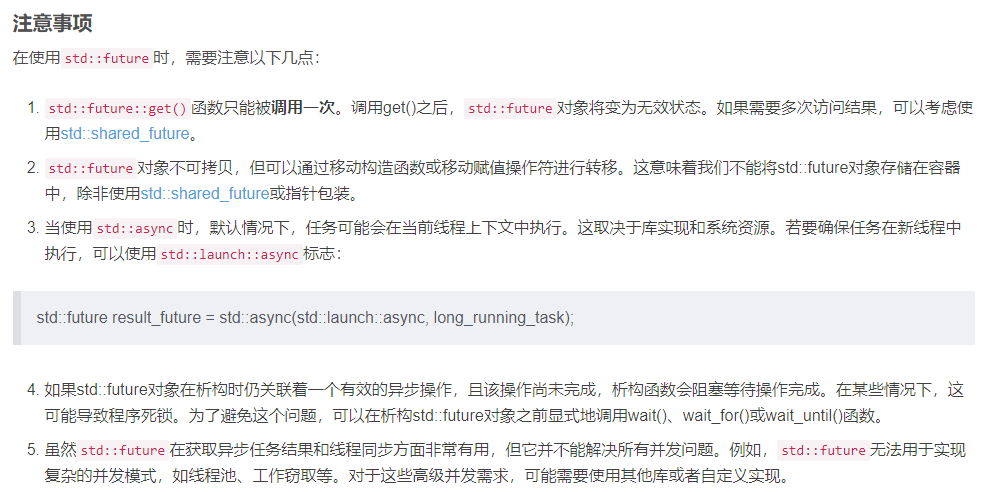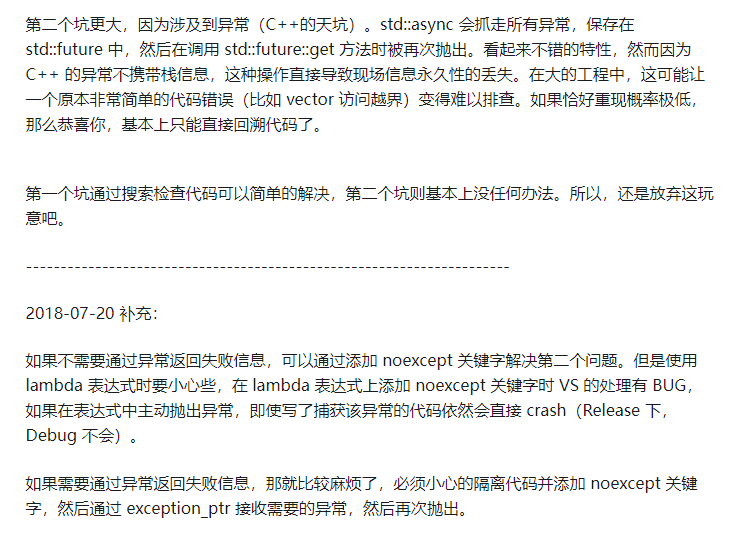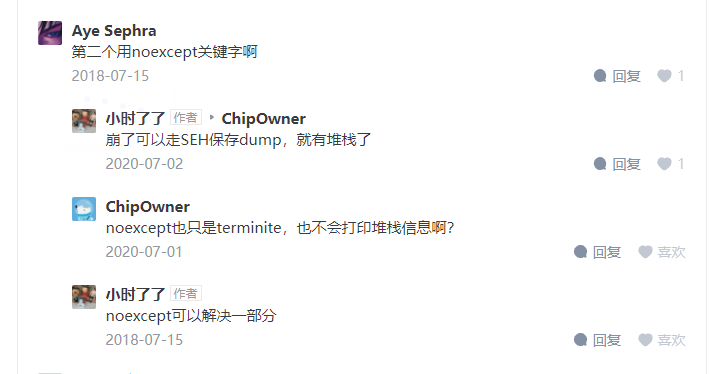boost--线程
1、thread的使用
boost的thread包含了线程创建、使用、同步等内容,使用thread需要包含头文件"boost\thread.hpp"。
thread中使用了需要编译的thread库,所以还需要添加thread库到项目附加库目录,在linux下链接thread库时还需要使用-lpthread选项来链接posix线程库。
如下所示,定义一个thread对象后,线程就开始执行。thread构造函数的第一个参数是一个函数或函数对象或function对象,剩余参数是传递给执行函数或函数对象的参数, 如果希望是引用传递的话则需要配合使用ref。
std::thread([]{ std::cout << "thread" << std::endl; }).detach();
定义一个thread对象后,在该对象销毁之前需要调用join()(阻塞等待)或者timed_join()(指定等待时间)来释放相关资源,否则需要调用detach()来将线程与调用线程的关联分离,线程结束后由运行时库负责清理该线程相关的资源,detach()的功能类似于posix的pthread_detach()。创建一个线程后默认的状态是joinable,调用detach()将线程执行体分离后,成员函数joinable()会返回false,即线程的状态是非joinable。
需要注意的是thread对象是不可拷贝的。

#include "boost\thread.hpp" void PrintThreadFunc(const int& n, const string& str) { cout << str << n << endl; } int main() { int n1 = 1; string str1 = "hello"; boost::thread t1(PrintThreadFunc, ref(n1), ref(str1)); int n2 = 2; string str2 = "boost"; function<void()> fun = bind(PrintThreadFunc, ref(n2), ref(str2)); boost::thread t2(fun); t1.timed_join(boost::posix_time::seconds(1)); //最多等待1秒 t2.join(); //一直等待 return 0; }
2、线程的一些操作
可以调用thread的成员函数get_id()获得线程ID,线程ID提供了比较操作符和流输出操作,因此可以作为标准容器的元素。当一个线程的状态是joinable的,那么可以调用成员函数get_id()获得线程ID,线程ID提供了比较操作符和流输出操作,因此可以作为标准容器的元素。如果调用了成员函数detach()将线程执行体分离,或者thread线程还未开始,那么get_id()获得一个空的id,即thread::id()。如下所示,启动线程有三种方法,并且演示了使用thread的get_id()来判断线程是否已经运行:
std::thread g_thd; void startThread2() { if (g_thd.get_id() == std::thread::id()) { //线程还未运行 g_thd = std::thread([] { // B方法启动线程:移动一个thread到另一个thread // ToDo }); g_thd.swap(std::thread([] { //C方法启动线程:交换两个thread // ToDo })); } } int main() { std::thread th1([](int n) { //A方法启动线程 // ToDo }, 100); startThread2(); }
静态函数this_thread::get_id()可以获得当前线程的线程ID。
静态函数thread::this_thread::sleep()可以让当前线程睡眠一段时间或到指定时间,
静态函数thread::hardware_concurrency()可以获得当前CPU的内核数量。
静态函数this_thread::yield()指示当前线程放弃时间片,允许其他线程运行。

boost::this_thread::sleep(boost::posix_time::seconds(2)); //睡眠2秒 cout << boost::this_thread::get_id() << endl; //输出当前线程ID cout << boost::thread::hardware_concurrency() << endl; //输出CPU核心数 boost::this_thread::yield(); //放弃当前CPU时间
c++11中也有对应的操作,eg:
std::this_thread::sleep_for(std::chrono::seconds(5)); //睡眠5秒
std::this_thread::sleep_for(4ms); //睡眠4毫秒,需要引用命名空间:using namespace std::chrono
3、线程中断
thread的成员函数interrupt()设置正在执行的线程被中断,被中断的线程会抛出一个thread_interrupted异常,它不是std::exception或boost::exception的子类。thread_interrupted异常应该在线程执行函数里捕获并处理,如下所示,如果没有捕获处理这个异常,默认的动作是终止线程。

void ThreadFun() try { //函数体 } catch (boost::thread_interrupted&) { //异常处理 }
线程其实不是任意时刻都能被中断的,只有当线程执行到中断点的时候才被中断,thread中的中断点有:thread::join()系列函数、thread::sleep()函数、condition_variable::wait()系列函数、this_thread::interruption_point()函数,其中this_thread::interruption_point()函数表示执行到本函数的时候就可以被中断。
缺省情况下线程都是允许中断的,this_thread::interruption_enabled()函数可以检测当前线程是否允许中断,this_thread::interruption_requested()用来检测当前线程是否被要求中断。this_thread中的disable_interruption类是一个RAII类型的对象,它在构造的时候关闭线程的中断,析构的时候恢复线程的中断状态。
4、线程组
线程组thread_group用于管理一组创建的线程,成员函数create_thread()可以创建thread对象并运行线程,也可以创建thread对象后使用成员函数add_thread()来加入线程组。成员函数create_thread()的声明如下:
template<typename F>
thread* create_thread(F threadfunc);
成员函数remove_thread()可以删除线程组里的thread对象,成员函数join_all()用来等待所有的thread对象,成员函数interrupt_all()用来中断所有的thread对象。
使用示例:

boost::thread_group tg;
int n1 = 0;
tg.create_thread(bind(ThreadFun1, n1, "c++"));
int n2 = 0;
tg.create_thread(bind(ThreadFun2, n2, "python"));
tg.join_all();
5、future与async()
如果想要获得异步函数的返回值,可以使用future。C++11中已经支持future。
我们在编程中使用异步任务时,可以使用std::async()。std::future可以帮助我们在需要的时候获取异步任务的执行结果,如下所示:

#include <iostream> #include <chrono> #include <future> int async_task() { std::this_thread::sleep_for(std::chrono::seconds(3)); return 100; } int main() { std::future<int> futureResult = std::async(std::launch::async, async_task); //异步的执行async_task() try { int result = futureResult.get(); //future::get()方法会阻塞等待,直到异步操作完成或发生异常. 可以使用std::future::wait_for()或std::future::wait_until()等待一段时间或等到某个时刻 std::cout << result << std::endl; //3秒后输出100 } catch (const std::exception& e) { std::cerr << "Exception caught: " << e.what() << std::endl; } catch (...) { std::cerr << "Unknown exception caught" << std::endl; } return 0; }
即使不需要关注异步任务返回值的话,也推荐使用一个future来保存std::async()的返回值,否则可能会出现问题,比如下面的代码,第二个异步任务会等待第一个异步任务执行完成后才开始执行。future只能移动不能拷贝,所以只能在一个线程中通过get()获得结果,如果想要多个线程能拿到结果,可以使用shared_future,通过future的shared()方法。
std::async(std::launch::async, [] { fun1(); });
std::async(std::launch::async, [] { fun2(); });
std::async()还支持延迟绑定,即直到调用std::future的get()或wait()才执行任务,通过指定std::launch::deferred,如下所示。同时std::async()也支持向异步任务传入参数:

std::mutex m; struct X { void bar(const std::string& str) { std::lock_guard<std::mutex> lk(m); std::cout << str << '\n'; } int operator()(int i) { std::lock_guard<std::mutex> lk(m); std::cout << i << '\n'; return i + 10; } }; int main(int argc, char** argv) { X x; auto a1 = std::async(std::launch::deferred, &X::bar, x, "world!"); //Calls x.bar("world!") with deferred policy: prints "world!" when a2.get() or a2.wait() is called a1.wait(); auto a2 = std::async(std::launch::async, X(), 43); //Calls X()(43); with async policy: prints "43" concurrently auto r = a2.get(); return 0; }
如果不使用std::async()而是使用thread创建新线程来执行异步任务的话,可以使用promise+future来实现子线程通知,而且promise可以实现任务还未结束的时候就通知,即在异步任务里进行通知(类似事件对象,但多出了通知值):

#include <iostream> #include <future> #include <thread> void task(std::promise<int> promiseResult) { std::this_thread::sleep_for(std::chrono::seconds(3)); int result = 42; promiseResult.set_value(result); // 将结果设置到promise对象中,其关联的future会立即得到通知 } int main() { std::promise<int> promiseResult; std::future<int> futureResult = promiseResult.get_future(); //获取promise关联的future std::thread task_thread(task, std::move(promiseResult)); int result = futureResult.get(); std::cout << result << std::endl; task_thread.join(); return 0; }
官方对std::async()的说明是"runs the function asynchronously (potentially in a separate thread which might be a part of a thread pool)",可以看到其并不保证任务通过线程池来执行,所以我们也可以自己通过thread pool来实现异步任务,通过promise+future获得任务的返回值。

以下是网上看到的关于std::async()与异常的问题,记录一下:


6、call_once()
call_once()用来设置在多线程环境下指定的函数只被调用一次。
7、C++11中的线程

#include <thread> void foo(int x) { x = 0; } void bar(int& x) { x = 0; } int main() { int n1 = 50, n2 = 100; std::thread first(foo, n1); std::thread second(bar, ref(n2)); first.join(); //first.detach(); second.join(); //second.detach(); cout << n1 << endl; //n1为50 cout << n2 << endl; //n2为0 return 0; }
需要注意的几点:
①、可执行的thread对象必须在他被销毁之前被主线程join(调用thread对象的join())或者将其设置为 detached(调用thread对象的detach),否则会产生abort。
②、如果使用函数对象作为thread的参数的话,直接传入临时对象会出错,可以定义一个对象传入或者使用lambda表达式:

class CTask { public: void operator()() { int a = 0; } }; //std::thread th1(CTask()); //直接传入临时对象会出错 CTask task; std::thread th1(task); th1.join();
③、传递给线程函数的参数是先保存在于一个中转站中,当函数执行的时候再传给函数的形参,而这个时候传递的参数指向的值很有可能已经失效,所以,对于线程函数传递的参数应该与形参类型相同,而不是再进行转换:

void task(int& a, string str) { } int iNum = 0; char* pStr = new char[100]; strcpy(pStr, "test"); //std::thread th(task, 5, std::ref(iNum), pStr); //不应该直接传入pStr,防止task中还未对参数str初始化成功pStr已被释放。 std::thread th(task, std::ref(iNum), string(pStr)); //应该传入对应类型 delete[] pStr; th.join();
④、如果线程函数的参数是引用的话传入时还需要使用ref包住传入的参数,否则也是值传递。


